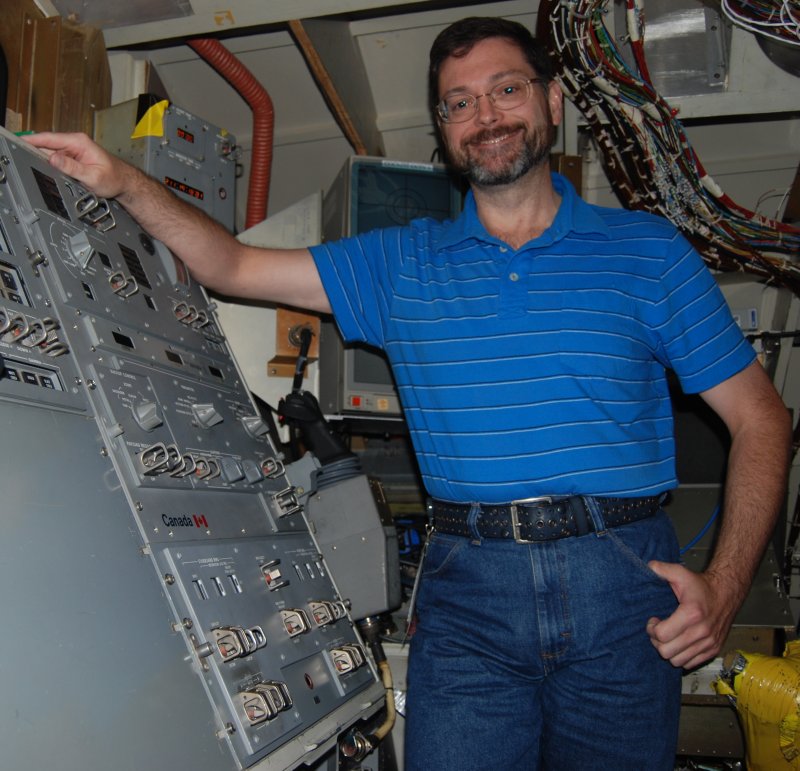Because of the 4th of July holiday here in the states — and because this is so darned cool! — I’m veering a little from the normal Math at Work Monday topic. We’re going to get a little geeky today with Andy Testa, a simulations and analysis engineer for NASA.

Andy Testa, simulation and analysis engineer
Okay, I don’t even know what a simulations and analysis engineer is, but yeah, Andy uses lots of math in his job–but not the way you think. He operates a robotic arm for the Space Shuttle, which will enjoy its last launch later this month.
So get your geek on, and enjoy a little independence from any math fear or anxiety you may have. Andy has a cool job that’s worth reading about!
Can you explain what you do for a living?
I work at NASA’s Johnson Space Center as a support engineer for the Space Shuttle’s robot arm, known as the Remote Manipulator System or Canadarm. I’m responsible for running computer simulations of the arm performing new tasks or moving new payloads and am also an expert on the arm’s control software running on the Shuttle’s computers. [pullquote]It isn’t efficient to do advanced math all the time. The hard stuff is built in to the simulators and special software that we develop one time. The day-to-day work is much more basic.[/pullquote] The simulations are usually to make sure that planned operations won’t stress the arm beyond what it’s designed to handle, which is surprisingly easy to do. I do troubleshooting when something doesn’t work right during a mission, whether that’s a software glitch, a mechanical failure, or an unplanned procedure that has to be simulated. Much of the time I’m working on backup plans for how to complete a mission if any number of potential failures happen.
When do you use basic math in your job?
When I describe my job to most people they respond with “I could never do that!” They imagine that I do a lot of advanced math, but the reality is that it isn’t efficient to do advanced math all the time. The hard stuff is built in to the simulators and special software that we develop one time. The day-to-day work is much more basic.
So, I use basic math every day. When working with robots like the Shuttle arm you’re constantly having to think about two things: the position of the tip of the arm in space, and the angles of all of the joints. These are related by geometry and trigonometry. I spend a lot of time working out geometry problems relating to the payloads that the arm moves. Each payload, like satellites or a piece of the Space Station, has to have a lot of numbers generated to allow the robot’s computer software to move them correctly. I need to calculate where the arm attaches itself, where the mass is centered, where the docking ports are located, and the direction the arm should move in when the astronauts move the controllers. Trigonometry is also used quite heavily, since I spend a lot of time worrying about angles and rotations, whether for each individual joint on the arm, or coordinated rotations of the payload as a whole.
Do you use any technology to help with this math?

That’s the robotic arm. (Photo courtesy of NASA)
Yes, we use computers constantly to help with the math, especially when we have to calculate trigonometry problems. Many of the problems I work on are similar enough that I can make a template for them in a spreadsheet, and use that over again with new payloads. For example, I frequently have to calculate a specific set of rotations to define how the arm attaches to payloads. By doing the calculations once and storing them in a spreadsheet, I can use it again just by inputting the unique geometry of each new payload. It saves a huge amount of time and effort, and lets me send all of the calculations to other people by sharing the files.
How do you think math helps you do your job better?
Not just better; without math my job would not be possible. Everything about spaceflight, including the Shuttle robot arm, is completely dictated by math. Knowing math not only allows me to continue to solve the problems we know about right now, but it also gives me the tools I need to figure out how to solve new problems.
How comfortable with math do you feel?
I feel quite comfortable with the level of math I use on a daily basis. I will frequently use similar math at home for hobbies or entertainment, for example, finding out exactly how much bigger a new widescreen TV is than my old tube TV.
What kind of math did you take in high school?
I took mostly standard college prep math classes in geometry and algebra. I didn’t take calculus until college. I was relatively good at math in high school, but I didn’t really understand it well until after a few years of practice in college.
Did you have to learn new skills in order to do this math?
Much of the math I use daily could be easily taught to someone with good high school math skills. Using the geometry and trigonometry to build descriptions of payload and robot motion is a skill that was developed more in college physics classes, though. That doesn’t mean it’s harder, just that it’s a specialized way of using the basic math that is being taught in high school. But the meat of what I do, hand calculating angles, areas, and sines and cosines, are straight out of basic high school math.
Thanks so much for playing, Andy! Readers, if you have questions, please feel free to post them in the comments section.